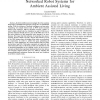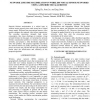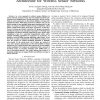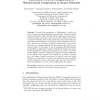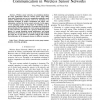ALGOSENSORS
2004
Springer
14 years 3 months ago
2004
Springer
In this work we present a new routing protocol for sensor networks that utilizes smart antennas to propagate information about a sensed event towards a receiving center. Our protoc...
SUTC
2010
IEEE
14 years 3 months ago
2010
IEEE
—Robotic middlewares increasingly allow the seamless integration of multiple heterogeneous robots into one distributed system. With the inclusion of ambient intelligence and perv...
ICMCS
2007
IEEE
14 years 3 months ago
2007
IEEE
Network lifetime maximization is a critical issue in wireless sensor networks since each sensor has a limited energy supply. Different from conventional sensors, video sensors com...
HOTOS
2009
IEEE
14 years 3 months ago
2009
IEEE
This paper makes the case that operating system designs for sensor networks should focus on the coordination of resource management decisions across the network, rather than merel...
ICDCS
2007
IEEE
14 years 3 months ago
2007
IEEE
As a key approach to achieve energy efficiency in sensor networks, sensing coverage has been studied extensively. Researchers have designed many coverage protocols to provide vario...
GSN
2009
Springer
14 years 3 months ago
2009
Springer
En-route data compression is fundamental to reduce the power consumed for data gathering in sensor networks. Typical in-network compression schemes involve the distributed computat...
GSN
2009
Springer
14 years 3 months ago
2009
Springer
We envision participatory texture documentation (PTD) as a process in which a group of participants (dedicated individuals and/or general public) with camera-equipped mobile phones...
ICC
2007
IEEE
14 years 3 months ago
2007
IEEE
Wireless sensor networks are promising solutions for many applications. However, wireless sensor nodes suffer from many constraints such as low computation capability, small memory...
GLOBECOM
2007
IEEE
14 years 3 months ago
2007
IEEE
Ad-hoc networks and sensor networks, where nodes communicate with each other without fixed infrastructure, are of great importance for many industrial, environmental, and safety-r...
SUTC
2010
IEEE
14 years 3 months ago
2010
IEEE
—To date many activity spotting approaches are static: once the system is trained and deployed it does not change anymore. There are substantial shortcomings of this approach, sp...

